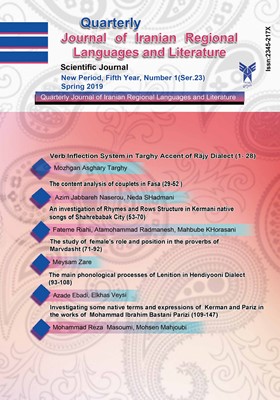An investigation of Rhymes and Rows Structure in Kermani native songs of Shahrebabak City
Subject Areas : ...Fatemeh Riahi 1 , Atamohammad Radmanesh 2 , Mahbobeh KHorasani 3
1 - Ph.D Candidate of Persian Language and Literature, Persian Language Department, Najafabad Branch, Islamic Azad University, Najafabad, Iran.
2 - Professor of Persian Language and Literature, Persian Language Department, Najafabad Branch, Islamic Azad University, Najafabad, Iran
3 - Associate Professor of Persian Language and Literature, Persian Language Department, Najafabad Branch, Islamic Azad University, Najafabad, Iran.
Keywords: Kerman, Rhymes, Rows, Native Poems, Shahrbabak,
Abstract :
The poet of ordinary poetry pays much more attention to music because music with an emotional effect prepares the mind of the audience to receive the poem's message. One of the most important pieces of music is rhyme and row in poetry; they have a special place in traditional Persian poetry and particularly in couplets form. In this article, in addition to introducing native songs and local couplets of Shahrebabak, the analysis of the structure of rhymes and rows has been done. Rhymes in native poems of Shahre-Babak, like all other dialects, are based on the alphabets of the near ending, and it is not based on the identical rhyming which is common in the formal Persian language. In cradlesongs and wedding poems, rhymes are sometimes removed to create music tone, or to use an extended pronouns to generate the rhythm. Rhyming is in the form of Masnavi in more than 10% of Shabarbak folk couplets. The rhymes of the same alphabets, like /M/, /R/, and /M/, /N/ and /L/, /R/ are more or less frequent in popular couplets of Shahrbabak. More than one over three of local couplets is associated with the row. Most of the couplets are in the "current" row and only 5 % of them has inactive rows. Row functions in local poems inspire the poet's inner sense, reinforce the poetry, help translating the concepts, emphasize an image or subject, and create a sense of pleasure.
کتابها
- حسینی موسی، زهرا،(1395)، بومیسرودههای شهربابک، کرمان،انتشارات مرکز کرمانشناسی.
- رازی، شمس قیس، (1360)، المعجم فی معاییر اشعار العجم، به کوشش مدرس رضوی، چاپ سوم، تهران، نشر زوار.
- رضوی، سیده شجاع ،(1377)، زبانشناسی و سبکشناسی در ادبیات و ادبیات عامه،تهران، چاپ زوّار.
- ریاحی، فاطمه(1395)، دوبیتیهای عامیانه شهربابک، کرمان، انتشارات ولی.
- شفیعی کدکنی، محمد رضا،(1370)، موسیقی شعر، چاپ سوم، تهران، نشر آگاه.
- محسنی، احمد، (1382)، ردیف موسیقی شعر، مشهد، نشر دانشگاهی فردوسی.
- مددی، حسن،(1385)، عروض و قافیه، تهران، تیرگان.
- ناصح، محمدمهدی،(1373)، شعر دلبر، مشهد، محقق.
- وحیدیان کامیار، تقی،(1357)، بررسی وزن شعر فارسی، تهران، آگاه.
- همایونی، صادق، (1345)، ترانههایی از جنوب، اداره فرهنگ عامه.
مجلات
- افروغ، محمد، (1387)، «علی در ترانههای عامیانه»، فصلنامۀ فرهنگ مردم، ش 12، ص131.
- ذوالفقاری، حسن، (1394)، کاربرد و ویژگی دوبیتی در بومی سرودههای ایرانی، مجلۀ ادبپژوهی، ش 32، صص 63-100.
-کمرپشتی، عارف ،(1390)،«وزن و قافیه در دوبیتیهای مازندرانی»، مجموعه مقالات اولین همایش ملی ادب محلی و محلی سرایان ایران زمین، یاسوج، دانشگاه آزاد اسلامی، صص 477-484.
- محسنی، مرتضی؛ کمرپشتی، عارف، (1394)، «تحلیل ساختار قافیه و ردیف در دوبیتیهای
مازندرانی شهرستان سوادکوه». فصلنامۀ ادبیات و زبانهای محلی ایرانزمین، ش 2، صص 125- 158
_||_

